Tag: entanglement
The History and Entanglement of the “Spezi” Trademark; What did Riegele and Paulaner Agree Back Then?
Hitachi Astemo Develops Prototype 360-Degree Stereo Vision with Multi-Camera 3D Sensing

 |
Most of the current automated driving systems are limited to highway driving. To enable automated driving systems to be used on general roads, they need to accurately recognize the entire road environment around the vehicle, including a complex mix of objects such as pedestrians and bicycles. Radar and LiDAR systems with high-ranging accuracy, however, still face cost issues before they can see widespread adoption, and all-surrounding-area camera systems, which although are superior in terms of cost,
are mainly based on a monocular camera that is still continually evolving to improve accuracy and other issues.
Hitachi Astemo, together with the Research and Development Division of Hitachi, Ltd., leveraged their strengths in stereo camera technology to develop a prototype of the 360-degree stereo vision system, using multi-camera 3D sensing that enables distance measurement with the stereo camera technology. Instead of the conventional module consisting of two cameras with the same view angle and being nearly parallel to each other, the camera layout has been made more flexible to use a combination of approximately 10 cameras with different angles of view, including non-parallel cameras to provide stereoscopic 3D vision. By integrating multi-camera 3D sensing into a single in-vehicle camera system, the system realizes 360-degree stereo vision, with a cost advantage, high accuracy and resolution.
By generating highly accurate distance information in stereo and all around the vehicle, the system can detect such elements as the distance of a vehicle traveling in the adjacent lane, or a two-wheeled vehicle slipping through a line of cars from behind in a traffic jam. It can estimate the relative speed and direction of movement, and apply this information for vehicle control to avoid collisions and entanglement at intersections. In addition to basic object recognition of objects such as cars, motorcycles, pedestrians, and traffic lanes, the recognition function also includes turn signals, red lights, and brake lights to predict the behavior of other vehicles; as well as traffic signals, road signs, road edges, and free space areas available for driving--all of which are necessary to identify for while driving on ordinary roads.
Furthermore, Hitachi Astemo has improved reliability and environmental resistance in camera sensing such as features to resist water droplets and dirt adhering to the lens surface, or shielding the entire lens in the snow. The AI has learned malfunction patterns caused by these factors and can identify malfunction factors that occur in each camera, thereby preventing malfunctions.
Going forward, Hitachi Astemo will continue to strengthen its 360-degree stereo vision systems that combine cost advantages with high accuracy and resolution, as well as improved reliability and environmental resistance, with the aim to expand the scope of automated driving systems for use on general roads.
Hitachi Astemo is committed to strengthening its business and delivering technological innovation through a strategic business portfolio, which consists of the Powertrain &
Safety Systems business, Chassis business, Motorcycle business, Software business and Aftermarket business. Aiming for a better environment globally and growth around the pillars of "green," "digital," and "innovation," we will deliver highly efficient internal combustion engine systems; electric systems that reduce emissions; autonomous driving for improved safety and comfort; advanced driver assistance systems; and advanced chassis systems. Through such advanced mobility solutions, we will contribute to realizing a sustainable society and provide enhanced corporate value for our customers.
For more information, please visit the Hitachi Astemo website: www.hitachiastemo.com/en/.
Copyright 2022 JCN Newswire. All rights reserved. www.jcnnewswire.comHitachi Astemo, Ltd. has developed a prototype 360-degree stereo vision system for automated vehicles traveling on regular streets. Based on multi-camera 3D sensing, the all-surrounding sensing system is both high-resolution and highly accurate.
Pipelines versus platforms: Power and the politics of knowledge
I see three patterns unfolding:
- the widening circles of human catastrophe from large changes in water and carbon cycling
- the widening failures of institutional solutions for these challenges
- the widening movement in agriculture and natural resource management toward peer-to-peer, participatory, local learning groups.
Is the age of miracle cures--of quick fixes, of institutional, top-down solutions for complex problems--on its way out? What patterns or possibilities are these widening ripples generating?
For agriculture in the U.S., the miracle cures of the 20th century include mechanization, pesticides, nitrogen fertilizer, large irrigation projects, biotechnology, and the development of a distribution system for these technologies. These revolutionized agricultural production around the world, with a singular focus on yields and efficiency. Agricultural research and extension, along with the land-grant university system in the U.S. that trains agronomists almost everywhere, effectively created a monopoly on the creation and distribution of knowledge. Huge corporations such as Monsanto-Bayer, Syngenta, and Cargill came to control inputs such as seeds and chemicals, agricultural methods, and marketing. Many agricultural lenders followed suit. These corporations also funded a good deal of agricultural research.
There have been great successes with many of these miracle cures and short-term fixes, and even today they are continuing. They have forestalled famines, reduced pest pressure in some cases, and saved farms from failure. They have enabled some countries to feed the world by exporting cheap food, extending their technology pipelines, and concentrating profit and power for the input sectors such as machinery, equipment, fertilizer, seed, and chemicals. They have helped maintain amazingly high levels of production on degraded and degrading soils, with increasing drought and pest pressure.
The oft-used analogy here is that of a pipeline, where research and development creates innovations and technologies which are then delivered to "end users" or farmers via channels and programs that provide information and incentives for adoption. It is a one-way flow, from the creators and developers of knowledge and technology to the presumed end users, driven by carrots and sticks (external motivations). The metric for success is the rate of flow: the adoption of practices or technologies, the signups to incentive programs, the sale of inputs.
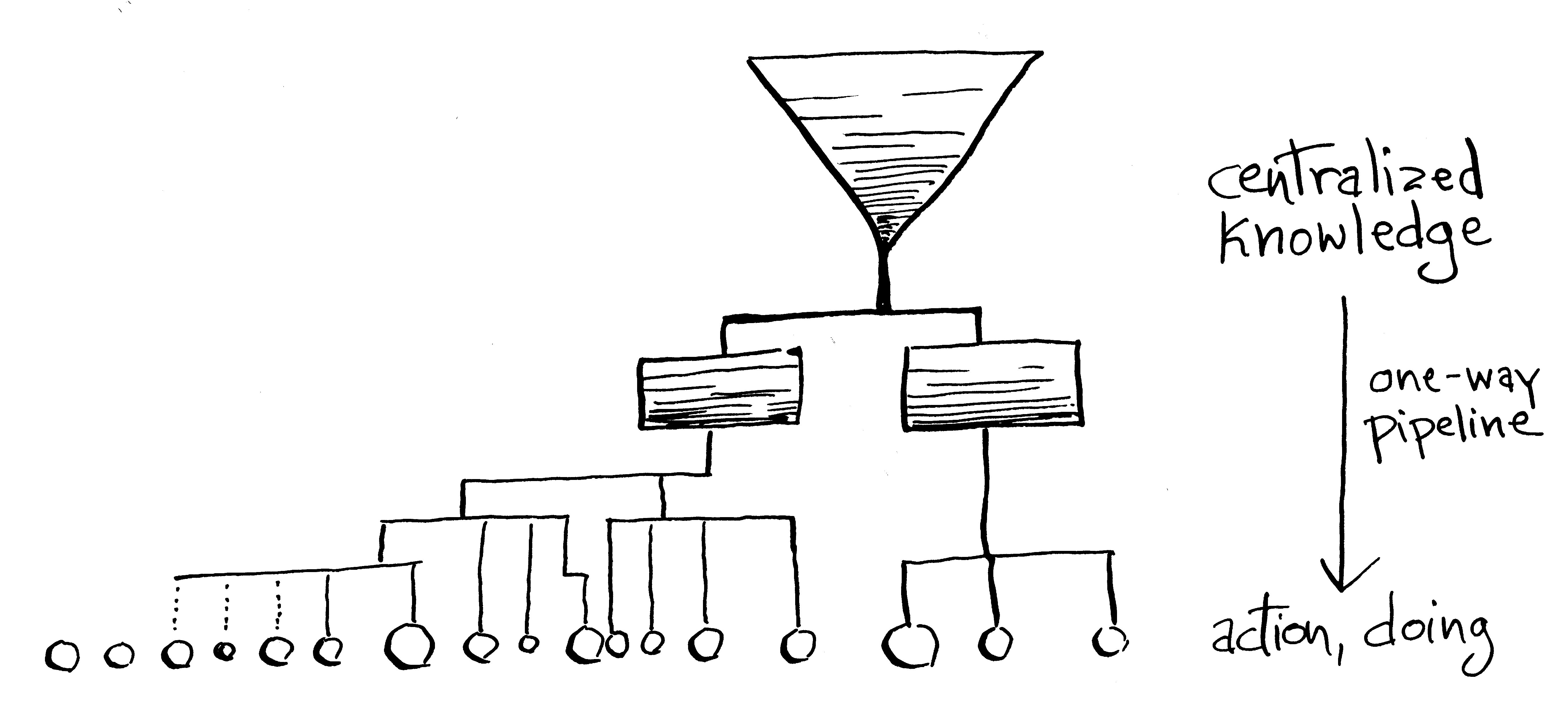
In complex domains such as ecosystems, the one-way pipeline design lacks good feedback or accountability. Researchers, input suppliers, and extension take charge of knowing, while farmers are responsible for doing. Knowing and doing are thus poorly correlated. The practices and strategies the one-way pipeline has delivered produce long-term, cascading failures: large-scale damage to soil health, desertification and compaction, massive loss of biodiversity, increased risk of erosion, drought, fire, and flood, much higher input costs, water quality issues and algal blooms, declining food quality, disappearing aquifers, more virulent weeds and pests, rising risks to human health, farm failure and consolidation, social conflict, and the hollowing out of many rural communities.
Institutional responses to these problems in the U.S. include adding different nozzles and channels to the pipeline: programs to promote conservation, sustainable agriculture, and climate-smart agriculture, to help underserved producers, to idle marginal and erodible land, crop insurance subsidies to de-risk agricultural production on increasingly degraded soils in a changing climate, to address marketing and rural community issues, for farmer mental health issues, and for institutional research on all of this.
There is also competition. Heretics and innovators have long challenged the monopoly of the USDA-land grant university axis for example on the creation and dissemination of knowledge and advice. The default or self-evident way to promote change is to set up another one-way pipeline through which an organization or consultancy can deliver its knowledge, information, best practices, and advocacy to its constituents. (See Deborah Frieze's trenchant critique and alternatives here.)
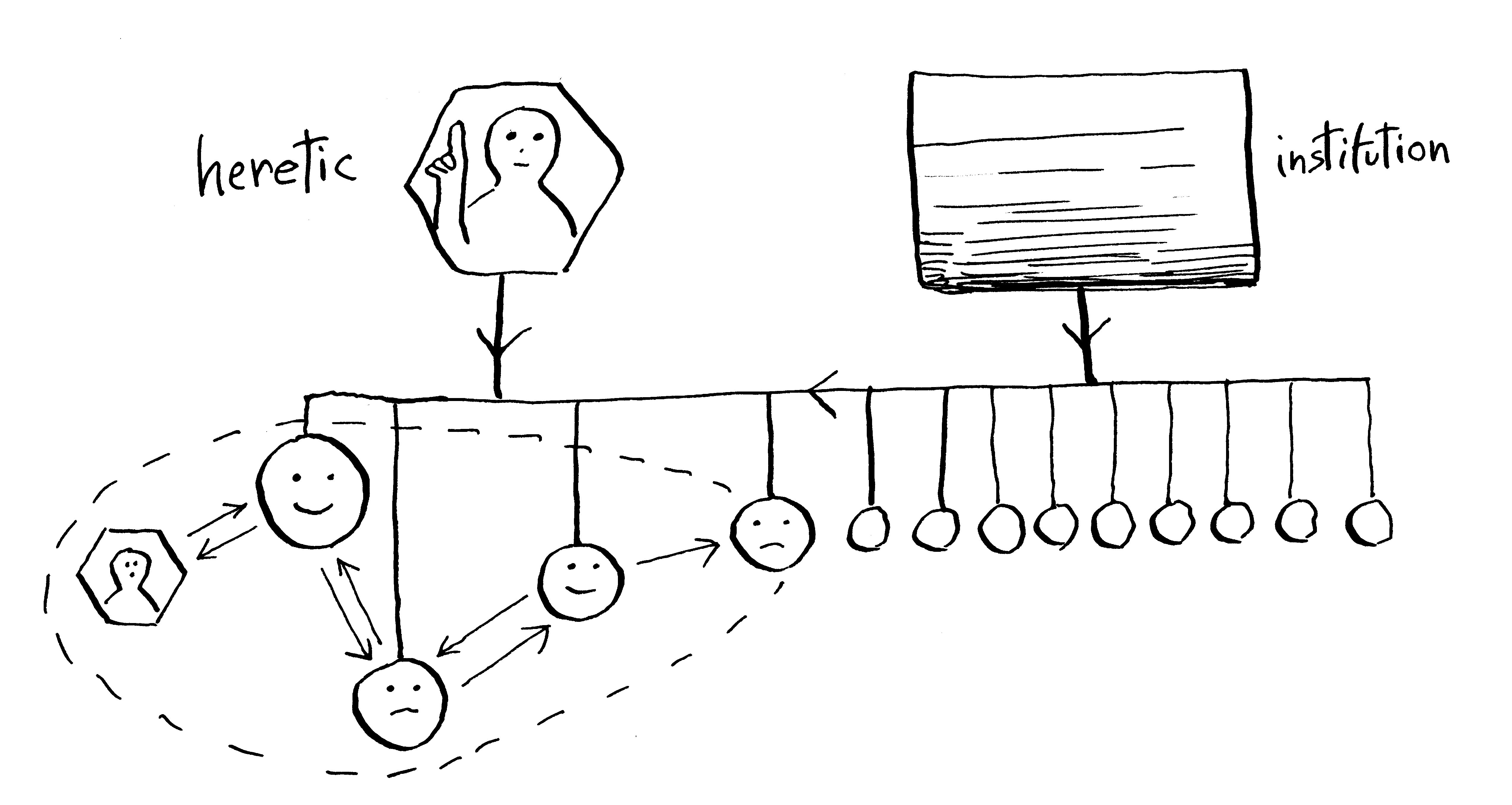
The Big Ag pipelines are still operating but there is increasing competition from sustainable, organic, or soil health movements and pipelines, which also compete with each other. Resistance and competition take many forms, including funding research to show that a rival movement's innovations don't work or can't be implemented, co-opting a movement's claims, various shades of greenwashing, and even partnership or combination.
Some heretics and innovators catalyze relationships between farmers, where similarly inclined or inspired farmers or ranchers begin to learn from each other, while still depending on pipelines for information, advice, or access to programs. This is the third pattern that is unfolding: the widening movement toward farmer-centered, peer-to-peer learning groups. This has been occurring for a long time, but in the last century the aforementioned institutional pipelines have displaced or sidelined a good deal of this activity.
Improving the productivity and soil health of a pasture or field is a complex challenge. As you might change the course of a fast-running stream by placing a log or rock in it, so the flow of sunlight energy through the pasture--photosynthesis, water cycling--means that small changes might produce large effects over time. Cause and effect may be entangled, like the chicken and the egg. There are lots of interacting variables, lots of unknowns, and some unknown unknowns.
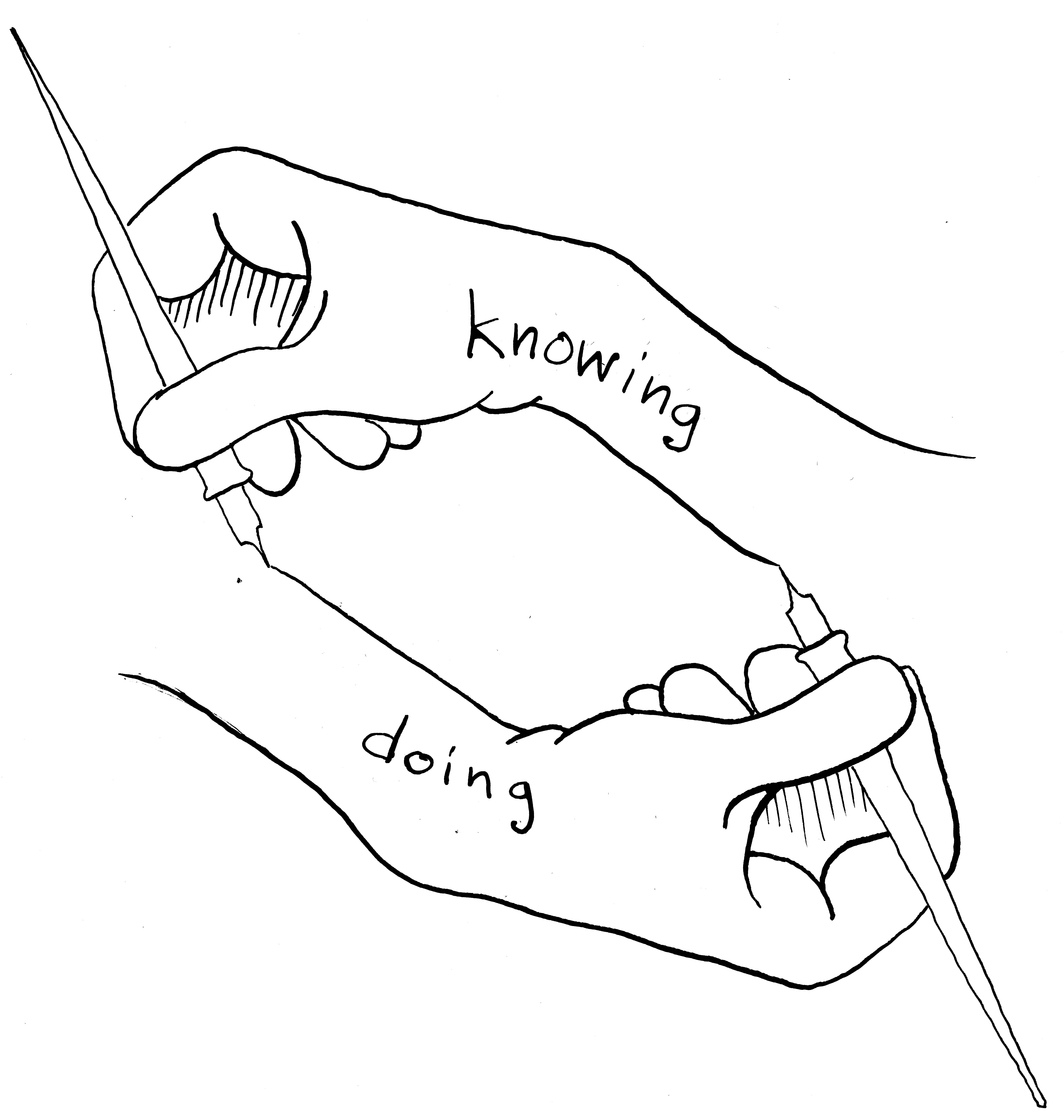
For knowing and doing, results and actions, to become correlated, the doers must also want to know--to accept the responsibility for their own education. This happens when farmers, ranchers, or land managers realize that there is a gap or discrepancy between their present situation, and what they recognize as needed, wanted, and possible. This gap can become a creative tension, an intrinsic motivation for learning that differs from the extrinsic motivations (carrots, sticks, and judgment) relied on by one-way pipelines.
While few seem to be abandoning the pipelines, the increasing popularity of farmer-to-farmer learning groups highlights the tension between top-down and bottom-up, between one-way pipelines and the must-have accountability of connected knowing/doing. Pipelines are still where the money and jobs are for educators, marketers, and consultants, and many farmers are either loyal, dependent, or both. Taking responsibility for your own learning in the face of complex challenges is scary and hard. Peer support is not everywhere to be found, and can be difficult to create and maintain. But a possible future pattern might be represented thus:
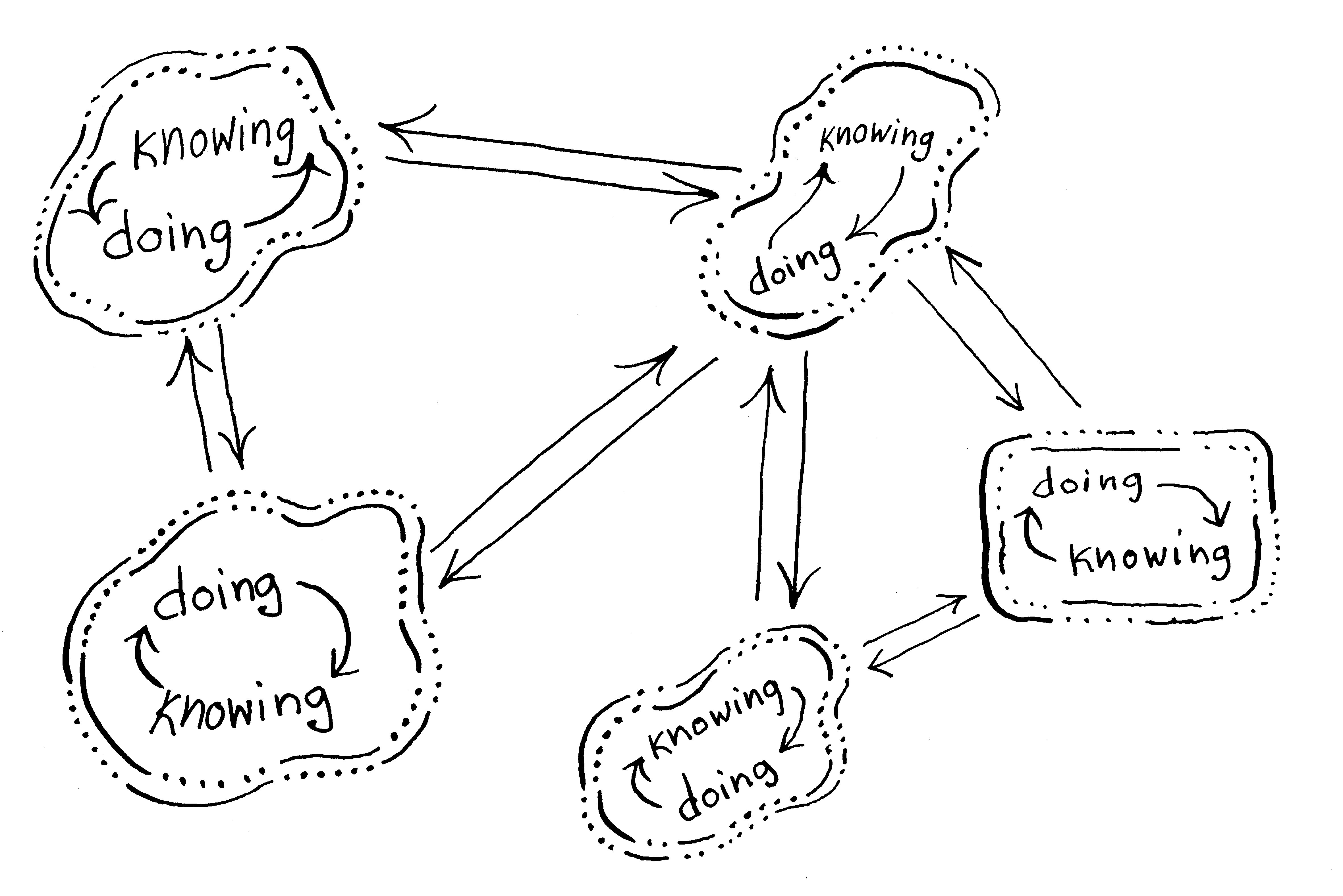
Aggregation has occurred, analogous to a process of soil aggregation. An institution (still somewhat rectangular) is now a participant in a learning network, with two-way exchange and internal accountability/feedback like the others--who may be individuals, or local groups of individuals. Internal accountability, the entanglement of knowing and doing at multiple scales, power sharing, the participatory co-creation of knowledge, as well as semi-permeable membranes that help protect against perverse incentives, are characteristic. It resembles an interdependent ecosystem.
Such ecosystems are unlikely to be created by policy, but their evolution could be supported where there is some kind of start. Some organizations and institutions are trying to support peer-to-peer farmer networks, but there often remains a subtle collaboration between their own habits, skills, and capacities on the one hand, and on the other the trained expectations of many farmers to be told best practices, to respond to carrots and sticks, to be judged by experts. The power and acclaim that expert status confers continues to be addicting. The result is that people can postpone taking responsibility for their own learning. Knowing and doing remain separated, and monitoring or science is outsourced.
We're in the midst of an evolution, for which effective shortcuts are unlikely to appear. Three elements that can support the connection between knowing and doing in the face of complex challenges:
- Group facilitation that is knowledgeable about the local situation, but sufficiently detached so that people can take responsibility for their own learning, their own progress. Facilitators learn to be a guide on the side, not the sage on the stage.
- Questions, including questions about evidence and trend in land function, that are relevant to people's intrinsic motivations, what they truly care about. Participants can pose their own questions, as well as methods of answering them.
- An adaptable platform or framework (not a one-way pipeline!) for participatory community science that respects trust, relationships, locality, and the needs and goals of participants, and supplies a way of fostering a shared intelligence, a group memory, evidence including some detailed answers to some key questions, and a semi-permeable membrane for sharing. This is the design of soilhealth.app.
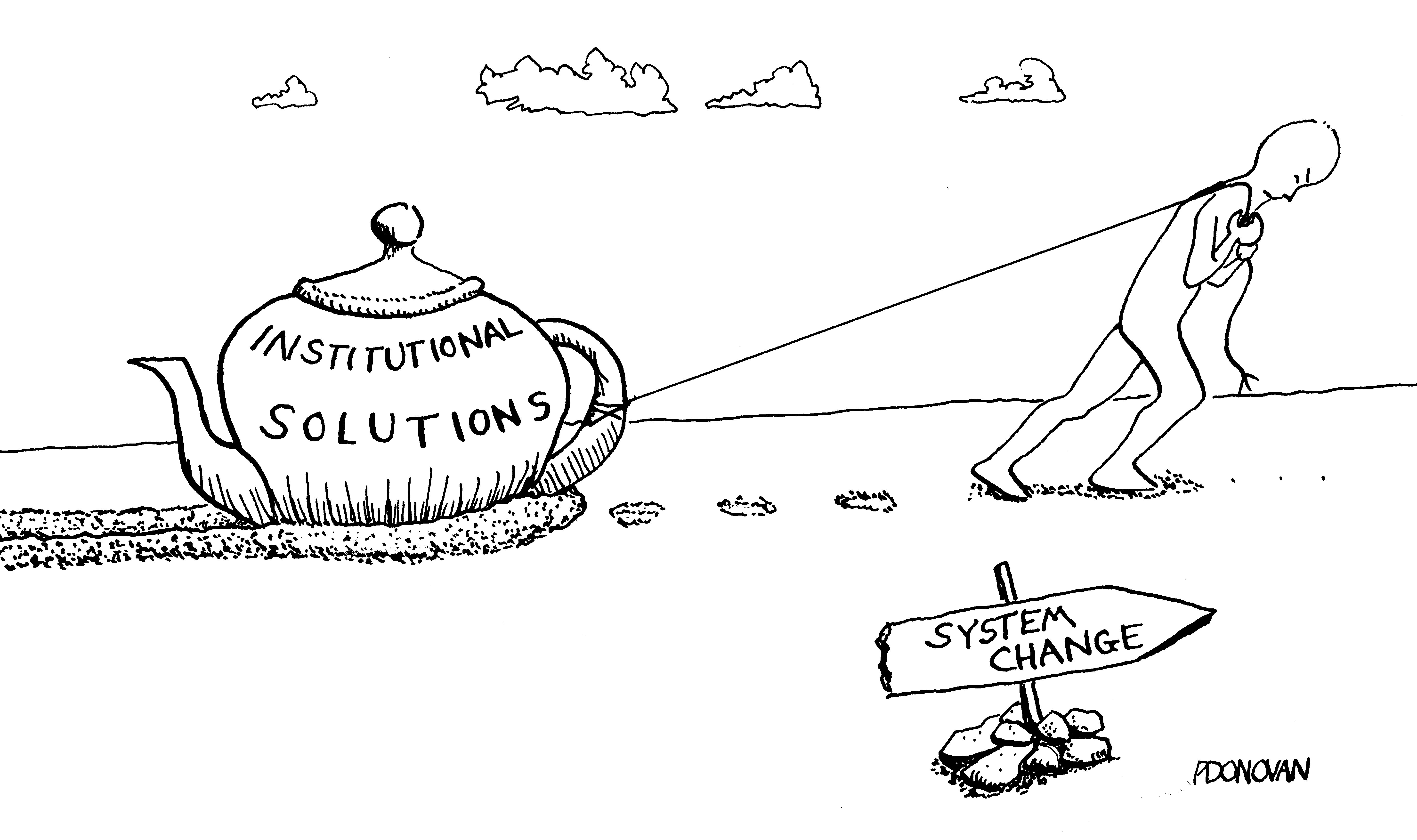
Institutional solutions . . . necessarily fail to solve the problems to which they are addressed because, by definition, they cannot consider the real causes. The only real, practical, hope-giving way to remedy the fragmentation that is the disease of the modern spirit is a small and humble way---a way that a government or agency or organization or institution will never think of, though a person may think of it: one must begin in one's own life the private solutions that can only in turn become public solutions. (Wendell Berry, The Unsettling of America, 1977)
Some further reading:
The Global Alliance for the Future of Food, a consortium of NGOs, has put out an excellent document called The Politics of Knowledge. Vijay Kumar from Andhra Pradesh was among the contributors. It calls for "participatory, transdisciplinary research and action agendas," and offers many insights into the tension between bottom-up, farmer-centered learning efforts, and the top-down pipelines that have sometimes sought to suppress or negate them.
Agroecology requires an approach to knowledge that transcends compartmentalized, reductionist, market-led, and elitist knowledge systems in favour of bottom-up, people-led, holistic, and transdisciplinary approaches to knowledge and wisdom.
The co-creation, exchange, and mobilization of knowledge and evidence creates new entry points to systemic transformation and needs to be harnessed to facilitate action across food systems. Evidence on its own does not catalyze change due to structural barriers, such as short-term thinking, cheap food, export orientation, and narrow measures of success, that keep industrial food systems locked in place. Unlocking these structural barriers requires changing our research, education, and innovation systems.
There are pdf and multimedia versions in English, Spanish, French here:
https://futureoffood.org/insights/the-politics-of-knowledge-compendium/
See also
Max Planck Generates Up To 14 Entangled Photons In A Defined Way And With High Efficiency
Deadly Optimism, Useful Pessimism
Operational nonclassicality in minimal autonomous thermal machines
Quantum 6, 672 (2022).
https://doi.org/10.22331/q-2022-03-22-672Thermal machines exploit interactions with multiple heat baths to perform useful tasks, such as work production and refrigeration. In the quantum regime, tasks with no classical counterpart become possible. Here, we consider the minimal setting for quantum thermal machines, namely two-qubit autonomous thermal machines that use only incoherent interactions with their environment, and investigate the fundamental resources needed to generate entanglement. Our investigation is systematic, covering different types of interactions, bosonic and fermionic environments, and different resources that can be supplied to the machine. We adopt an operational perspective in which we assess the nonclassicality of the generated entanglement through its ability to perform useful tasks such as Einstein-Podolsky-Rosen steering, quantum teleportation and Bell nonlocality. We provide both constructive examples of nonclassical effects and general no-go results that demarcate the fundamental limits in autonomous entanglement generation. Our results open up a path toward understanding nonclassical phenomena in thermal processes.
Local and scalable detection of genuine multipartite single-photon path entanglement
Quantum 6, 671 (2022).
https://doi.org/10.22331/q-2022-03-22-671How can a multipartite single-photon path-entangled state be certified efficiently by means of local measurements? We address this question by constructing an entanglement witness based on local photon detections preceded by displacement operations to reveal genuine multipartite entanglement. Our witness is defined as a sum of three observables that can be measured locally and assessed with two measurement settings for any number of parties $N$. For any bipartition, the maximum mean value of the witness observable over biseparable states is bounded by the maximum eigenvalue of an $Ntimes N$ matrix, which can be computed efficiently. We demonstrate the applicability of our scheme by experimentally testing the witness for heralded 4- and 8-partite single-photon path-entangled states. Our implementation shows the scalability of our witness and opens the door for distributing photonic multipartite entanglement in quantum networks at high rates.
Proposal for room-temperature quantum repeaters with nitrogen-vacancy centers and optomechanics
Quantum 6, 669 (2022).
https://doi.org/10.22331/q-2022-03-17-669We propose a quantum repeater architecture that can operate under ambient conditions. Our proposal builds on recent progress towards non-cryogenic spin-photon interfaces based on nitrogen-vacancy centers, which have excellent spin coherence times even at room temperature, and optomechanics, which allows to avoid phonon-related decoherence and also allows the emitted photons to be in the telecom band. We apply the photon number decomposition method to quantify the fidelity and the efficiency of entanglement established between two remote electron spins. We describe how the entanglement can be stored in nuclear spins and extended to long distances via quasi-deterministic entanglement swapping operations involving the electron and nuclear spins. We furthermore propose schemes to achieve high-fidelity readout of the spin states at room temperature using the spin-optomechanics interface. Our work shows that long-distance quantum networks made of solid-state components that operate at room temperature are within reach of current technological capabilities.
SPIDER-Gentleman in Virtual Truth is BRUTAL – Boneworks VR Multiplayer
Quantum scrambling of observable algebras
Quantum 6, 666 (2022).
https://doi.org/10.22331/q-2022-03-11-666In this paper we describe an algebraic/geometrical approach to quantum scrambling. Generalized quantum subsystems are described by an hermitian-closed unital subalgebra $cal A$ of operators evolving through a unitary channel. Qualitatively, quantum scrambling is defined by how the associated physical degrees of freedom get mixed up with others by the dynamics. Quantitatively, this is accomplished by introducing a measure, the geometric algebra anti-correlator (GAAC), of the self-orthogonalization of the commutant of $cal A$ induced by the dynamics. This approach extends and unifies averaged bipartite OTOC, operator entanglement, coherence generating power and Loschmidt echo. Each of these concepts is indeed recovered by a special choice of $cal A$. We compute typical values of GAAC for random unitaries, we prove upper bounds and characterize their saturation. For generic energy spectrum we find explicit expressions for the infinite-time average of the GAAC which encode the relation between $cal A$ and the full system of Hamiltonian eigenstates. Finally, a notion of ${cal A}$-chaoticity is suggested.
Market Wrap: Equities Seesaw as Ukraine Unpredictability Continues

Investors are watching the developing conflict in Ukraine and await Biden's executive crypto order and new interest rates
The post Market Wrap: Equities Seesaw as Ukraine Unpredictability Continues appeared first on Blockworks.
Infocus International brings back Carbon Capture, Utilisation and Storage (CCUS) masterclass

 |
This course is intended for those in business, commercial and strategically focused roles within the energy sector; in particular those responsible for environmental matters, business sustainability and business transformation in areas such as oil & gas, hydrogen and industrial energy usage.
Attendees will leave with a clearly explained and independent perspective on how, where and why CCUS is happening now and could grow in future - covering the range of technological solutions and business drivers, including policy. In addition to reviewing existing CCUS approaches, the course will highlight new opportunities and integrated value creation possibilities through carbon utilisation. This will include how the fate of CCUS links to other aspects of the clean energy transition, such as clean hydrogen production, industrial decarbonisation and the transition away from oil & gas.
Past attendee from Solar Clear shared, "This course has provided a good understanding and cleared all false expectations about CCUS and of its cross entanglement to the hydrogen sector and the importance of both for decarbonising the world's (or part of the world's) economy."
"The up-to-date information was provided in course. The materials were available before the course, that is why it was possible to think about questions. The course materials were logically structured. The lecturer was highly professional. The organization of course was wonderful. Thank you very much!," said a past participant from Latvenergo.
Course Sessions:
- Carbon sources & capture technologies
- Carbon storage, transport & utilisation
- Hydrogen, carbon and industrial clusters
- Growing CCUS: scalability, markets, policies & strategies
Benefits of Attending:
- Understand the most challenging aspects of the clean energy transition & the role of CCUS in addressing them
- Examine the various technological aspects of the CCUS value chain, from capture through to storage and/or utilisation pathways
- Discuss the key economic and policy variables which will determine how CCUS plays out in different markets
- Review up-to-date examples of projects and strategies from around the world, and evaluate the lessons from them
- Learn the dynamics of the new competitive environment, including the risks of "business as usual" and the importance of industrial clusters in CCUS deployment
- Identify approaches to sustainable strategic planning and new business opportunity assessment
Want to learn more?
Simply email to emilia[at]infocusinternational.com or call +65 6325 0210 to obtain your FREE COPY of event brochure. For more information, please visit https://www.infocusinternational.com/ccus.
About Infocus International Group
Infocus International is a global business intelligence provider of strategic information and professional services for diverse business communities.
Infocus International recognises clients' needs and responds with innovative and result oriented programmes. All products are founded on high value content in diverse subject areas, and the highest level of quality is ensured through intensive and in-depth market research from local and international insights.
Emilia Mok
Tel: +65 6325 0210
Email: emilia[at]infocusevent.com
Website: www.infocusinternational.com
Copyright 2022 ACN Newswire. All rights reserved. www.acnnewswire.comInfocus International Group is bringing back the highly recommended Carbon Capture, Utilisation and Storage (CCUS) online masterclass and it will be commencing live on the 5th of July 2022.



